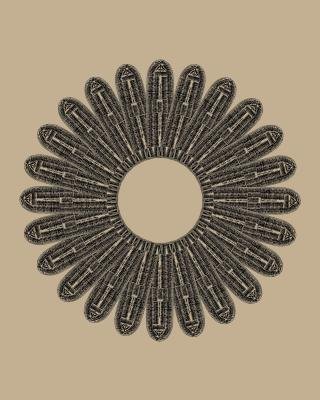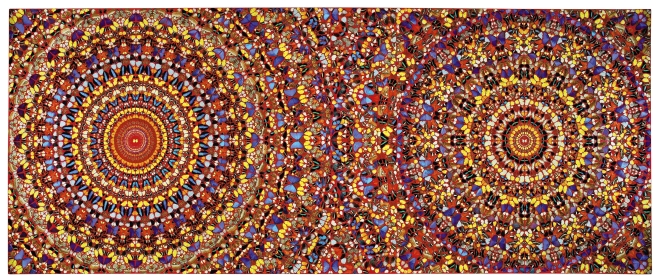Contextualisation Key Point
Documentation Key Points
Contextualisation Key Point
Documentation Key Points
The mind creates, the body reproduces. In the material reality, art objects are reproductions of the mind , a mind that uses the body as an organism to materialize ideas, patterns, and emotions. My work examines the need for artistic creation as a means of bridging the gap between our conscious and unconscious minds. Inspired by Jungian theory of Individuation, I explore the therapeutic necessity of art in the modern age. Integrating the symbolic nature of circular forms, found in ancient cultures through to today’s society, in conjunction with my own body parts as an expression and representation of the thoughts and feelings that may not be accessible through conscious effort. Resulting in a fuller understanding of the decisions we make in life through revealing manifestations of hidden thoughts, feelings, and motives.
Website Address – http://enfysradley.wix.com/enfysradleyfineart
Victor Moscoso is an American artists associated with the psychedelic art movement, best known for the posters, advertisements, and underground comix he produced, during the 60s/70s. Unlike many psychedelic artists of the time, Moscoso had formal artistic training. He consciously decided on his use of colour, influenced by one of his teachers, Josef Albers. His use of vibrant colours in combination with the use of photographic collage within his work is what has drawn me to explore his work. I find his work has a more refined feel to it in comparison to other psychedelic artists, which isn’t always a good thing when the art seeks to recreate an alternate sense of unconsciousness.
At the beginning of my research into the origins/ effects of Mandalas, I believed it was the positive link we create at a young age between circular forms and our caregivers faces – oval shapes.A 2007 study conducted by (Empirical study on the healing nature of mandalas.Henderson, Patti; Rosen, David; Mascaro, Nathan. Psychology of Aesthetics, Creativity, and the Arts, Vol 1(3), Aug 2007, 148-154.) The nature of the study was to examine the healing effects of creating Mandalas on people suffering from post traumatic stress disorder, the outcomes were measured in terms of changes in PTSD symptoms along with levels of anxiety, depression and growing levels of spirituality. After a 1 month period, the results showed an overall decrease in symptoms. While also allowing those who could not discuss the traumatic events they had endured, an alternative way to process their trauma.
Below are some artworks using mandala creation as a form of therapy sessions.
These mandala are then assessed through ‘The Mandala Assessment Research Instrument’ (MARI) is a way of deciphering the psychology behind the choice of symbols and colours a person choose to create a Mandala, colours and symbols that Jungian theory states depict a literal picture of the psyche.
Sanford Biggers is a contemporary American artists, whose work has been exhibited across American and Europe. Biggers uses film, video, installation, sculpture, drawing, performance and has even composed his own music, to explore and offer a new perspective on established symbols with hip-hop, Buddhism, politics identity and art history. His work in relation to spirituality consists of circular pieces, such as his lotus series, as seen below.



Damien Hirst is a world renowned artist, whose work deals with an array of subject matter, and takes influences from some on modern art’s greatest artists, such as, Andy Warhol, Francis Bacon and Marcel Duchamp. He challenges the notion of modern art, for instance, his 1989 piece ‘The Physical Impossibility of Death in the Mind of Someone Living’, a piece that has become an iconic image of contemporary art. Consisting of a thirteen-foot tiger shark, which Hirst arranged to be caught off the coast of Queensland, Australia, and preserved in formaldehyde and contained within 3 glass and steel cubes. Explaining “I didn’t just want a lightbox, or a painting of a shark” Hirst’s intention was to force the viewer out of their element by introducing into a gallery setting, a shark that was “real enough to frighten you”.[2] By isolating the shark from its natural habitat, with the formaldehyde providing an illusion of life, the work explores our greatest fears, and the difficulty involved in adequately trying to express them. As Hirst states: “You try and avoid [death], but it’s such a big thing that you can’t. That’s the frightening thing isn’t it?

 Circular and symmetrical imagery has become an important theme within my work, it has come to symbolise a wholeness that can be create through creative outlets, and a gateway to connecting the conscious and unconscious mind. Something that Freudian and Jungian theory believe is the key to overcoming self destructive/ negative behaviours. Damien Hirst is an artist who has frequently used symmetrical repetition within his work to examine human spirituality/ the soul/ the psyche.
Circular and symmetrical imagery has become an important theme within my work, it has come to symbolise a wholeness that can be create through creative outlets, and a gateway to connecting the conscious and unconscious mind. Something that Freudian and Jungian theory believe is the key to overcoming self destructive/ negative behaviours. Damien Hirst is an artist who has frequently used symmetrical repetition within his work to examine human spirituality/ the soul/ the psyche.

Kaleidoscope Series
The above are piece from Hirst’s Kaleidoscope series, something which he continued for a number of years, made up of thousands of multicoloured butterflies placed into intricate geometric patterns into paint. Hirst uses butterflies in reference to the Greek symbolism of the butterfly representing the soul/ psyche.

Discussing his work Hirst – “I’ve got an obsession with death … But I think it’s like a celebration of life rather than something morbid.”[1] Something which circular forms have come to represent, a wholeness. Hirst decided to only use the wings and not the body of the butterfly, divorcing it from reality, creating an almost mythical/ dream like being. To me this is very symbolic of the conscious and unconscious mind, the perception of our consciousness, an accessible, very real part of human existence contrasting our unconsciousness where great creativity and mysterious inner working of the mind reside.
Capaneus Series
Leading on from Hirst’s Kaleidoscope series, is Capaneus a collection of pieces that use a variety of insects, butterflies, beetles arranged into intricate patterns and placed into gloss paint. The title derives from the Latin poem ‘Thebaid’ where Capaneus is struck down to earth by angered deities, the poem describes how he falls to the ground engulfed in flames, his lifeless body as immense as that of a giant, creating beauty out of tragedy. Similar to the irony of having to kill something to appreciate its beauty, referring to the use of insects within Hirst’s work.
We now understand so much more about the functions of the human mind than ever before, on a multitude of different levels, not only the mechanical side, but also aesthetic appreciation. But even with these leaps and bounds in the scientific world, the sheer number of artists in the forefront of their disciplines that suffer from at least one mental illness is staggering. From Vincent Van Gogh and Virginia Woolf , who subsequently took their own lives, to Georgia O’Keefe and T.S Eliot who were institutionalised during their careers Adrienne. The definition of mental illness, and what constitutes as creativity can be extremely vague. But in more recent years, there have been solid scientific findings to connect the two. Research into the creative work of people suffering from schizophrenia, have been particularly informative on the subject of creativity creating further knowledge on psychological disorders. Displaying the need for art in
Above are two works of art by Vincent Van Gogh, the first was painted while Van Gogh was in an asylum, and reflects his mental state at the time. Peaceful town, turbulent sky, contrast.Vincent Van Gogh, an impressionist painter, was a major influence in the German Expression movement, his post-impressionist paintings paved the way for modern art. Van Gogh’s work has been admired by people all over the world, the expressionists admired his contrasting colours, and dynamic brushstrokes. His suffering is clearly portrayed in his work, and confirmed in his letters to his younger brother theo, Where the expressionist so greatly inspired by Van Gogh because he had discovered a way of expressing his psyche through art
Georgia O’Keefe

Mati Klarwein is the artist behind numerous famous 60’s/70’s psychedelic album art work, including Miles Davies and Jimmy Hendrix. Klarwein was born in Germany, he gain artistic influence and knowledge through his father, Joseph Klarwein, an architect affiliated with the Bauhaus movement. A movement synonymous with individual ideas and expression, something Klarwein clearly displays within his own work.


During the early 1960’s Klarwein would meet some extremely influential figures, including Jimi Hendrix and Salvador Dali.This was a time of great inspiration for Klarwein, his work at this time reflects his interest in pop culture and surrealism, and most importantly symbolism, inspired by his travels to the east.
Klarwein is still best known for his art of the 1960s and 1970s, with its clear links to surrealism, popular psychedelic imagery, ethnic and exotic themes, erotic, and religious art from a number of different traditions.
Klarwein travelled all around the world including Tibet, India, Bali, North Africa, Turkey, Europe and the Americas, during his travels he learnt about different beliefs and traditions. This is clearly seen within Klarwein’s work, for instance the contrasting use of colour, symbolic of the yin yang. An Asian belief of balance being the key to a harmonious being.
